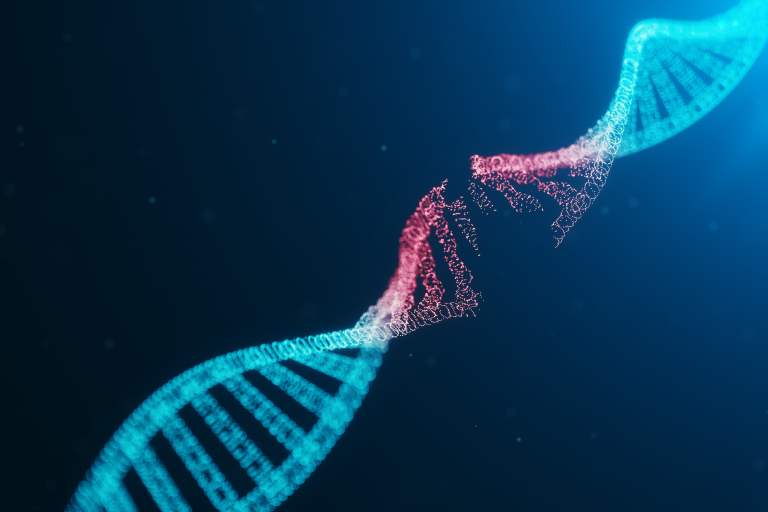Written by Dr. Ambika Tewari Edited by Dr. Maria do Carmo Costa
Mutations in Ataxin-3 protein prevent the normal functioning of a DNA repair enzyme leading to an accumulation of errors
Cells are bombarded by thousands of DNA damaging events each day from internal and external sources. Internal sources include routine processes that occur within cells that generate reactive byproducts, while external sources include ultraviolet radiation. This DNA damage can be detrimental to cells. But the coordination of many DNA repair proteins helps to maintain the integrity of the genome. This prevent the accumulation of mutations that can lead to cancer.
DNA repair proteins play very important roles in the nervous system. During development, cells are actively growing and dividing and can incur many errors during these processes. Therefore, it is not surprising that numerous DNA repair proteins are expressed in the mammalian brain to prevent the accumulation of DNA damage. To much DNA damage can produce devastating consequences.

In fact, DNA repair deficiencies usually result in profound nervous system dysfunction in humans. Examples include neurodegeneration, microcephaly and brain tumors. Altered DNA repair signaling has been implicated in neurodegenerative disorders such as Alzheimer’s disease, Parkinson’s disease, and Huntington’s disease. This implicates DNA repair proteins in genome maintenance in the nervous system. There are many different types of DNA damage and DNA repair. Each repair process has its own proteins and sequence of events that lead to either repair or cell death.
Ataxin-3 is known for its role in Spinocerebellar ataxia type 3 (SCA3), an autosomal dominant disorder caused by a repeat expansion in the ATXN3 gene. Symptoms are progressive and include prominent ataxia, impaired balance, spasticity and eye abnormalities. These symptoms are primarily a result of cerebellum dysfunction, but brainstem and spinal cord regions also show abnormalities in SCA3 patients. Recent studies have shown that ataxin-3 is part of a complex of proteins that repair single-strand DNA breaks. A crucial member of this complex, polynucleotide kinase 3’-phosphatase (PNKP), is actively involved in not only repairing single-strand but also double-strand breaks. Since the activity of PNKP is dependent on ataxin-3, this group of researchers were eager to investigate whether ataxin-3 also functioned in the repair of double-strand DNA damage.
Repair of double-strand breaks involves two different pathways. In the adult brain, neurons do not divide so these cells use the classical nonhomologous end-joining (NHEJ) pathway to repair DNA damage. In NHEJ, the broken ends of the DNA are directly ligated and require the coordinated activity of several other proteins. While PNKP has been shown to function in the NHEJ pathway, the role of ataxin-3 in this pathway is unknown.
Using tissue from the cerebellum of normal mice, the researchers showed that ataxin-3 interacts with a number of key proteins within the NHEJ pathway. When non-proliferating cells were treated with a DNA damaging agent, there was an increase in the interaction of ataxin-3 with members of the NHEJ pathway. Furthermore, when levels of ataxin-3 were dramatically reduced in human cells, there was an increase in signatures of DNA double-strand breaks. Together, this data provided substantial evidence of ataxin-3’s role in the NHEJ repair of double-strand DNA damage.
The research group made a fly model of SCA3 expressing a fragment of human mutant ataxin-3 protein in fly eyes. These flies developed severe eye abnormalities that were progressive and also showed DNA strand breaks. When PNKP was overexpressed to four times its normal level, SCA3 flies with elevated levels of PNKP showed reduced strand breaks and a partial improvement in symptoms. Therefore, increasing PNKP levels was shown to alleviate the DNA damage induced by mutated ataxin-3 in flies.
To further validate their findings in disease-relevant models, the researchers used a mouse model of SCA3. They also used postmortem cerebellum tissue collected from patients with SCA3. They found an increase in DNA double-strand breaks in SCA3 brains compared to controls. Interestingly, these breaks were found specifically in genes that were being actively transcribed. There are several genes that are important for the maintenance of each cell. The messages of these genes are constantly being read or transcribed to ensure that the normal functions of the cell continue without interruption.
In support of this evidence, fewer genes were found to be transcribed in SCA3 tissue from cells, mice and human patients. When genes incur DNA damage, their messages cannot be read, or alternatively, an erroneous message is interpreted. Without proper instructions, a cell has no idea how to proceed and fails to perform its normal functions. In the case of SCA3, this can manifest as abnormalities in different areas of the brain, like the cerebellum, spinal cord and brainstem, and can even extend to individual cell types.
This is a very thorough and comprehensive study that builds on previous data implicating ataxin-3 in the DNA damage response pathway. They used a number of cell lines, animal models, both mouse and fly, and human patient tissue. The researchers confirmed their findings across these models. They showed elegantly that ataxin-3 is an important contributor to the repair of DNA double strand breaks in the NHEJ pathway. This adds to a growing list of functions for ataxin-3, a multifunctional protein.
Key Terms
Neurodegeneration: The progressive loss of function of neurons.
Transcription: The process by which information in one strand of DNA is copied into a message known as a messenger RNA.
Microcephaly: A condition where a baby’s head is smaller than normal, usually due to abnormal brain development.
Conflict of Interest Statement
The author and editor declare no conflict of interest.
Citation of Article Reviewed
Chakraborty, A, et al. Deficiency in classical nonhomologous end-joining-mediated repair of transcribed genes is linked to SCA3 pathogenesis. Proceedings of the National Academy of Sciences, 2020. 117:14 pg. 8154-8165 (https://doi.org/10.1073/pnas.1917280117)









